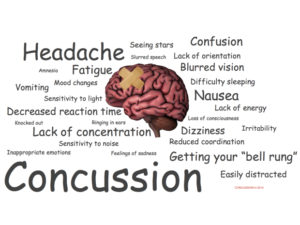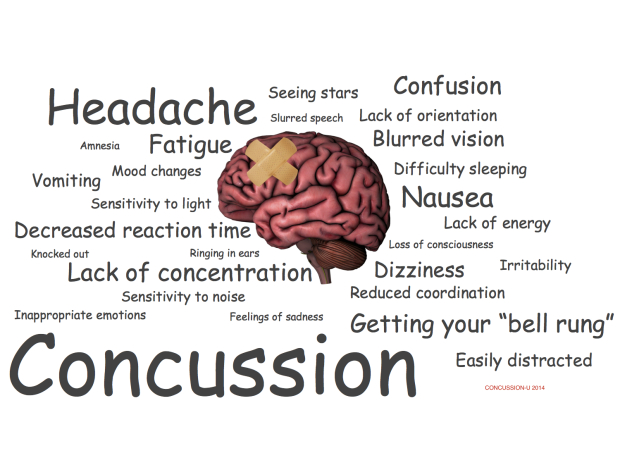 The subject of concussions has become impossible to ignore. In the past, a head injury was simply shrugged off as a minor injury and many of us were told to continue on with activity once we regained our senses. As an athlete, coach, parent or physician, we need to recognize the symptoms and appropriate treatment of this potentially life threatening injury.
The subject of concussions has become impossible to ignore. In the past, a head injury was simply shrugged off as a minor injury and many of us were told to continue on with activity once we regained our senses. As an athlete, coach, parent or physician, we need to recognize the symptoms and appropriate treatment of this potentially life threatening injury.
CNN’s Dr. Sanjay Gupta does a great job of explaining concussions in simple terms.
Know anyone who had his or her ‘bell rung’? Or have you ‘dinged’ your head and ‘saw stars’? If so, the following may ‘rattle your brain’ as to what a concussion is and the seriousness if not treated or managed properly.
Key points:
- A concussion can be a serious injury, seek medical care.
- Individual management depends on the specific presentation and circumstances that are unique to each individual case.
- The management of concussions in athletics is continually evolving in sports medicine.
- Complete cognitive rest is the standard of care.
- There is no special imaging for a concussion.
So…. What is a concussion????
According to the American Medical Society for Sports Medicine a concussion is defined as “a traumatically induced transient disturbance of brain function and involves a complex pathophysiological process”. This is basically stating that trauma to the head or other part of the body can cause the brain to become injured, what we know as a concussion.
Think of a concussion as a ‘bruise to your brain’ and this may help you understand the mechanism. A bruise can be ever so slight or can be so severe as to cause bleeding and a lot of pain- this is what happens to your brain as well. Also, depending on the person, the bruise can be very painful or not painful at all; but there is still damage to the area and it needs time to heal. What I am trying to portray is that a concussion can be small or large and the symptoms can vary from person to person and day by day. But what happens when we don’t allow the bruise to heal?
A second injury to the brain before it has adequate time to recover results in greater deficits and can even be catastrophic. This is known as second impact syndrome (SIS). SIS has been overlooked by many athletes, coaches, parents, trainers, and doctors over the years. Today we have more knowledge to help prevent catastrophic injuries such as SIS, but we need to know what to look for. As athletes, we need to know what our body is saying to us. As parents, we need to note any behavioral changes and physical changes to the concussed child. As doctors, we need to know how to treat the concussion and when it is safe for the athlete to return to play. We are all part of the team- athlete, parent, and doctor- to help keep athletes safe during sport.
Signs and symptoms:
- may or may not have a brief loss of consciousness
- memory issues (before or after trauma)
- drowsiness/sluggishness
- dizziness
- double vision or blurry vision
- sensitivity to light or sound
- headache
- nausea or vomiting
- balance and/or coordination issues
- slowed/impaired reaction to stimuli
Some symptoms resolve within hours after trauma, others can linger for weeks or months post injury. This is why it is EXTREMELY important to seek out medical care. Only under a qualified medical professional’s care and release can an athlete be fit and SAFE to return to sport.
There is NO special test or imaging to diagnose a concussion. A computed tomography scan (CT scan) can detect if there is a brain bleed, but cannot detect if the brain has suffered a concussion. The diagnosis is based on symptoms and monitored closely day-by-day by a qualified medical professional.
The MOST important key to recovery is COMPLETE COGNITIVE REST. This means no outside stimulus- no TV, no video-games, no reading/writing, no school work, no playing sports- basically rest and DO NOTHING! Relax and let the brain heal. The old way of thinking- “do not let a concussed person sleep” is not the standard of care anymore. More rest and more sleep is the best way for the brain to heal.
A few key points from The American Chiropractic Board of Sports Physicians’ position statement on sports related concussion in athletics are:
- Concussion may be caused by a direct blow to the head or elsewhere on the body.
- Loss of consciousness is a key symptom but the majority of concussions do not involve a loss of consciousness.
- Individuals with a concussion may present with a wide range of signs and symptoms such as physical signs of neurologic impairment, or/and symptoms of impaired brain function that may include abnormal behavior.
Re-cap of the Key points:
- A concussion can be a serious injury, seek medical care.
- Individual management depends on the specific presentation and circumstances that are unique to each individual case.
- The management of concussions in athletics is continually evolving in sports medicine.
- Complete cognitive rest is the standard of care.
- There is no special imaging for a concussion.




While I agree with most of what you have written, I disagree with your statement of not having tools to absolutely diagnose a concussion. Concussive activity shows up as hyperlocking of neurons when measured by a Quantitative EEG. Check out Brainattention.com, it will answer any questions.
Michele, thanks for the information and the link!